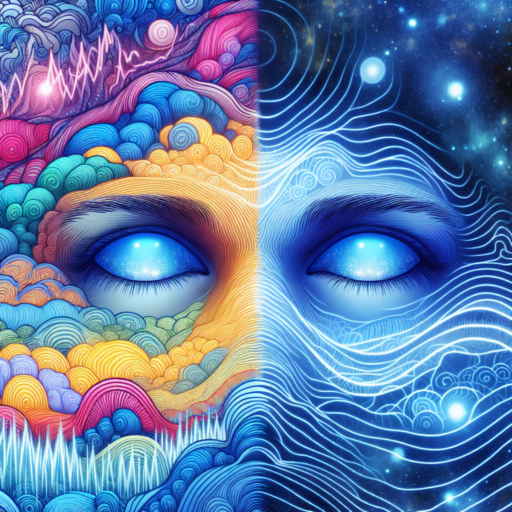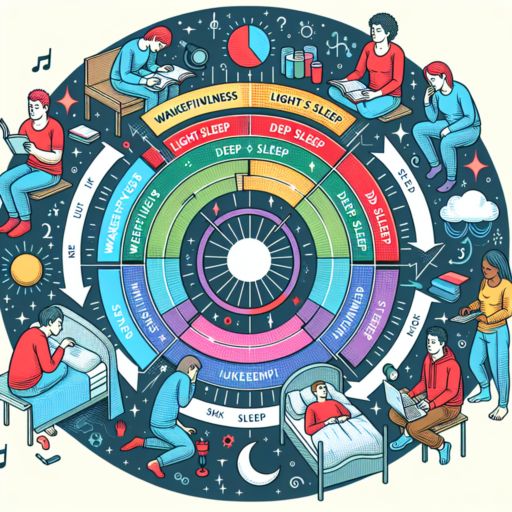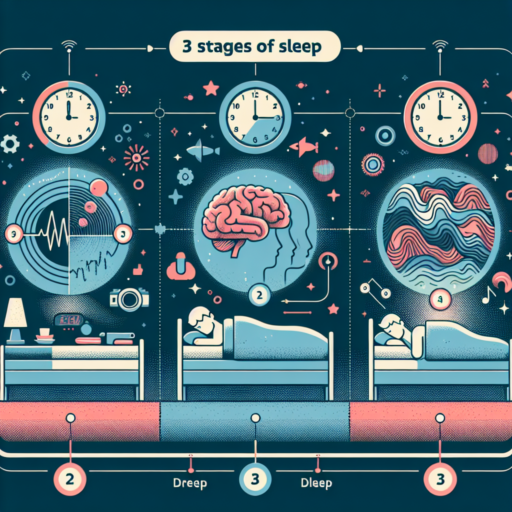Understanding REM Sleep vs Deep Sleep: A Comprehensive Guide
When it comes to rejuvenating sleep, understanding the differences between REM (Rapid Eye Movement) sleep and deep sleep is crucial. While both stages are essential for a healthy sleep cycle, they serve different purposes in our rest and recovery. REM sleep is often associated with dreaming, brain activity, and memory consolidation. In contrast, deep sleep, or slow-wave sleep, is critical for physical recovery, growth, and immune function.
The cycle of sleep stages begins with light sleep, progresses to deep sleep, and then moves to REM sleep. A typical sleep cycle lasts about 90 minutes, and this cycle repeats several times throughout the night. Deep sleep usually dominates earlier in the night, making way for increased periods of REM sleep closer to morning. This balance supports both emotional health and physical wellness, highlighting the importance of experiencing both REM and deep sleep stages each night.
Key differences in physiological markers also define REM and deep sleep. During REM sleep, the brain’s activity mirrors that of being awake, with rapid eye movements and relaxed muscles, except for occasional twitches. This stage is critical for processing emotions, consolidating memories, and creativity. Alternatively, deep sleep is characterized by slow brain waves, known as delta waves, decreased heart rate, and relaxed breathing. It’s during this stage that the body focuses on healing and growth, repairing tissue, and strengthening the immune system.
The Importance of REM and Deep Sleep for Your Health
Understanding the critical roles of REM (Rapid Eye Movement) and deep sleep is essential for optimizing our health and well-being. These sleep stages are crucial for mental and physical recovery, playing significant roles in memory consolidation, emotional regulation, and the rejuvenation of our bodies.
Memory Consolidation and Cognitive Function
REM sleep is particularly important for memory consolidation, a process where short-term memories are transformed into long-term ones. Additionally, this sleep stage is linked with enhancing cognitive functions, including problem-solving skills and creativity. Therefore, ensuring an adequate amount of REM sleep could be the key to boosting mental performance.
Emotional Health and Well-being
The role of REM and deep sleep extends beyond cognitive processes, deeply influencing our emotional health. During REM sleep, our brains process emotional experiences and can help mitigate the impact of stressful or traumatic events. This mechanism highlights the therapeutic potential of REM sleep in managing mental health disorders.
In conclusion, the importance of REM and deep sleep in maintaining and enhancing our health cannot be overstated. Their roles in supporting cognitive functions, emotional regulation, and physical health underscore the need to prioritize sleep quality in our daily lives.
Comparing REM and Deep Sleep: What are the Key Differences?
Understanding the distinction between REM (Rapid Eye Movement) sleep and deep sleep is crucial for comprehending our sleep cycles and their impact on our health. REM and deep sleep serve different functions in our sleep architecture, each playing a unique role in our overall well-being.
Function in the Sleep Cycle
One of the key differences between REM sleep and deep sleep lies in their function within the sleep cycle. Deep sleep, also known as slow-wave sleep, is primarily responsible for the body’s physical restoration. It’s during this phase that the body repairs tissues, builds bone and muscle, and strengthens the immune system. On the other hand, REM sleep is associated with the processing of emotions, memory consolidation, and brain development. This phase is characterized by rapid eye movements, increased brain activity, and vivid dreams.
Timing in the Sleep Cycle
The timing of REM and deep sleep throughout the night also differs significantly. Typically, a person experiences cycles of sleep stages that last about 90 minutes each. Deep sleep tends to occur in the first half of the night, with the longest periods happening in the first few cycles. In contrast, the amount of REM sleep increases in each cycle, with the longest periods occurring in the second half of the night. This distribution highlights how the body prioritizes physical restoration before transitioning to psychological and emotional processing.
In summary, both REM and deep sleep are integral to health, yet they serve different purposes within our sleep cycles. By understanding these distinctions, we can better appreciate the complexity of sleep and the importance of each stage in our overall health and well-being.
How to Optimize Your Sleep for More REM and Deep Sleep Stages
To achieve a night filled with more REM (Rapid Eye Movement) and deep sleep stages, it’s essential to focus on sleep hygiene practices that set the stage for high-quality rest. REM and deep sleep are crucial for cognitive functions and overall health, making their optimization a priority for anyone looking to improve their sleep quality.
Maintain a Consistent Sleep Schedule
One of the most straightforward yet effective strategies for enhancing REM and deep sleep is maintaining a regular sleep pattern. Going to bed and waking up at the same time every day, even on weekends, helps regulate your body’s internal clock. This consistency can promote longer durations of REM and deep sleep cycles, as your body becomes accustomed to this routine.
Create a Restful Environment
Your sleeping environment plays a pivotal role in reaching the deeper stages of sleep. Ensure your bedroom is conducive to rest by keeping it cool, dark, and quiet. Investing in a comfortable mattress and pillows can also make a significant difference. Additionally, consider using white noise or earplugs to block out disruptive sounds, and blackout curtains or an eye mask to mitigate light intrusion, which can inhibit your progression into deep and REM sleep stages.
Limit Exposure to Blue Light and Stimulants
Exposure to blue light from screens and consumption of stimulants such as caffeine and nicotine can severely impact your ability to fall asleep and progress into the REM and deep sleep phases. Limiting screen time at least an hour before bedtime and avoiding stimulants in the late afternoon and evening can help your mind and body prepare for a restorative night’s sleep. Embrace activities that promote relaxation, such as reading or meditating, to further enhance your pre-sleep routine.
The Impact of REM and Deep Sleep on Brain Function
Understanding the roles of REM (Rapid Eye Movement) and deep sleep stages is essential to grasp how sleep affects our brain function. These stages are crucial for various aspects of brain health and cognitive processes. REM sleep, often associated with vivid dreams, plays a significant role in memory consolidation and emotional regulation. Deep sleep, on the other hand, is crucial for physical restoration, detoxification of the brain, and the consolidation of long-term memories.
Diving deeper into the impact on brain function, during the REM stage, the brain is remarkably active. This phase is critical for processing and storing memories, learning, and balancing our moods. Scientists believe that the brain during REM sleep is engaging in a form of mental housekeeping, sorting and storing the day’s experiences, and discarding the unnecessary information. This stage of sleep has been linked with improved problem-solving skills, memory retention, and creative thinking.
In contrast, deep sleep is often referred to as the body’s repair mode. During this stage, the body releases growth hormones, which aid in cell repair and growth, further emphasizing its role in physical health. Additionally, deep sleep contributes to the glymphatic system’s efficiency, a unique waste clearance system of the brain. By removing toxins that can accumulate and lead to neurodegenerative diseases, deep sleep acts as a protective measure for long-term brain health and cognitive function.
Strategies to Enhance REM Sleep and Achieve Deeper Sleep
Improving the quality of your sleep, especially Rapid Eye Movement (REM) sleep, is crucial for both mental and physical well-being. REM sleep, a critically restorative sleep phase, is often disrupted by various lifestyle and environmental factors. Luckily, with the right strategies, you can increase your REM sleep duration and achieve deeper, more restful nights.
Establish a Consistent Sleep Schedule
Maintaining a regular sleep schedule is paramount for optimizing REM sleep. Going to bed and waking up at the same time every day, including weekends, helps regulate your body’s internal clock. This consistency enables your body to naturally anticipate sleep, making transitions into REM phases smoother and more frequent.
Avoid Stimulants Before Bedtime
Substances such as caffeine and nicotine can severely impact your ability to fall into deep sleep cycles, including REM sleep. It’s advisable to avoid caffeinated beverages or foods at least six hours before your intended bedtime. Similarly, steer clear of nicotine, as it acts as a stimulant that disrupts sleep patterns, diminishing the quality and duration of REM sleep. Limiting intake or avoiding these substances can significantly enhance sleep quality.
Optimize Your Sleep Environment
Crafting a sleep-friendly environment is another effective strategy to increase REM sleep. Ensure your bedroom is quiet, dark, and cool. Use blackout curtains or eye masks to block light, and consider white noise machines to drown out disruptive noises. The temperature of your room also plays a critical role in sleep quality; a cool room, typically around 65 degrees Fahrenheit, is optimal for most individuals. These small adjustments can make a substantial difference in facilitating deep, uninterrupted REM sleep.
Understanding the Sleep Cycle: Transitioning Between REM and Deep Sleep
The complexity and significance of the sleep cycle have captured the attention of scientists and laypersons alike. Primarily, understanding how the human body transitions between Rapid Eye Movement (REM) and Deep Sleep stages holds the keys to comprehending overall sleep health. This transition is not just a trivial part of our night but a critical determinant of the quality of rest we get.
During a typical night, a sleeper transitions through various stages, starting from light sleep, moving into deep sleep, and then entering REM sleep. The cycle is typically repeated several times. It is during the deep sleep phase that the body repairs itself, consolidates memory, and strengthens the immune system. After a period in deep sleep, the body transitions to REM sleep, a phase characterized by rapid eye movement, increased brain activity, and dream occurrence. This stage is crucial for cognitive functions such as learning, memory, and emotional regulation.
The transition between REM and deep sleep is a delicate process influenced by numerous factors, including age, lifestyle, and health conditions. As we age, we tend to spend less time in deep sleep and more in REM, affecting our overall sleep quality. Understanding this transition can highlight potential sleep disorders or areas where one’s sleep hygiene could improve.
Common Misconceptions About REM Sleep and Deep Sleep
When it comes to understanding the intricacies of sleep, specifically REM (Rapid Eye Movement) sleep and Deep Sleep, there’s a sea of misinformation and myths that cloud public perception. Both stages of sleep play critical roles in our health and well-being, yet they are often misunderstood. Here, we aim to demystify some of the common misconceptions surrounding REM sleep and deep sleep.
Misconception #1: REM Sleep Is the Deepest Stage of Sleep
One prevalent misconception is that REM sleep is the deepest stage of sleep. However, this is not the case. Deep sleep, or slow-wave sleep, which typically occurs in the earlier part of the night, is the deepest phase of sleep. During this time, the body repairs and regrows tissues, builds bone and muscle, and strengthens the immune system. On the other hand, REM sleep, which is more associated with the dreaming portion of sleep, plays a crucial role in memory consolidation and mood regulation. It’s essential to differentiate between these stages to fully understand their contributions to overall health.
Misconception #2: You Can Easily Make Up for Lost Deep Sleep
Another common fallacy is the belief that missing out on deep sleep or REM sleep can be easily compensated with just a few extra hours of shut-eye the next night. Unfortunately, sleep doesn’t work that way. Sleep cycles progress through stages, including light sleep, deep sleep, and REM sleep, in a specific order. Skipping or shortening one phase cannot be fully recouped with merely more sleep later on. This misunderstanding often leads to undervaluing the importance of a consistent sleep schedule for maintaining balanced health.
Misconception #3: More REM Sleep Equals Better Sleep Quality
Lastly, the idea that more REM sleep equals better sleep quality is a misconception. While REM sleep is indeed vital for mental restoration, a healthy sleep cycle includes balanced proportions of all stages, including deep sleep and light sleep. Focusing on increasing only REM sleep overlooks the holistic nature of restorative sleep and its myriad benefits across all stages. It’s crucial to focus on achieving a balanced sleep cycle for optimal health and well-being.
The Role of REM and Deep Sleep in Emotional Well-being
Sleep plays a pivotal role in maintaining overall health, especially when it comes to emotional and mental well-being. Within the sleep cycle, Rapid Eye Movement (REM) and deep sleep phases are crucial for processing emotions, managing stress, and supporting a balanced mood. Understanding how these stages work can provide insight into the complexity of sleep’s impact on our emotional health.
REM sleep, the stage most associated with vivid dreams, goes beyond mere storytelling at night. Neuroscientific research suggests that during REM sleep, the brain processes and synthesizes emotional experiences from the day. This phase acts as a form of overnight therapy, helping to diffuse emotional intensity and allowing for emotional regulation. Conversely, a deficiency in REM sleep has been linked to heightened anxiety and difficulty coping with daily stressors.
In parallel, deep sleep — the phase of sleep characterized by slow brain waves, known as delta waves — plays its part in emotional well-being by supporting the restoration of the body and brain. This stage is critical for cognitive functions and memory consolidation, including the assimilation of emotional content. During deep sleep, the brain also clears out toxins, potentially reducing the risk of neurodegenerative diseases and contributing to a more stable emotional state.
Technological Advances in Monitoring REM vs Deep Sleep
In the realm of sleep science, distinguishing between Rapid Eye Movement (REM) and Deep Sleep has been a topic of paramount importance. Thanks to cutting-edge technology, tracking and analyzing these distinct sleep stages has made significant strides. These advancements are instrumental in enhancing our understanding of sleep patterns, improving sleep quality, and addressing sleep-related disorders.
One of the standout technologies is the development of wearable sleep trackers. These devices employ sophisticated sensors to monitor movement, heart rate, and even oxygen levels during sleep. By analyzing this data, they can accurately distinguish between REM sleep, known for its role in memory consolidation and learning, and Deep Sleep, which is crucial for physical recovery and health.
Integration with Smart Home Devices
Another groundbreaking achievement in the field is the integration of sleep tracking technology with smart home devices. This synergy allows for the automatic adjustment of environment settings, such as temperature and lighting, based on the detected sleep stage. This not only improves the onset of sleep but also enhances the quality by fostering optimal conditions for transitioning between REM and Deep Sleep phases effectively.










